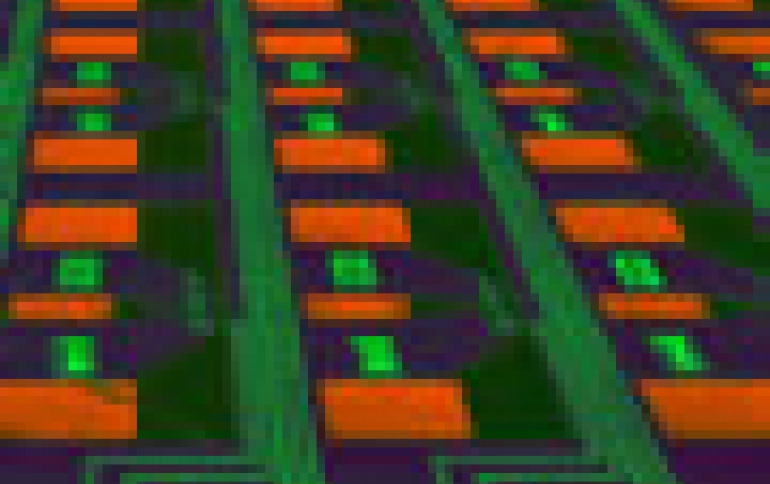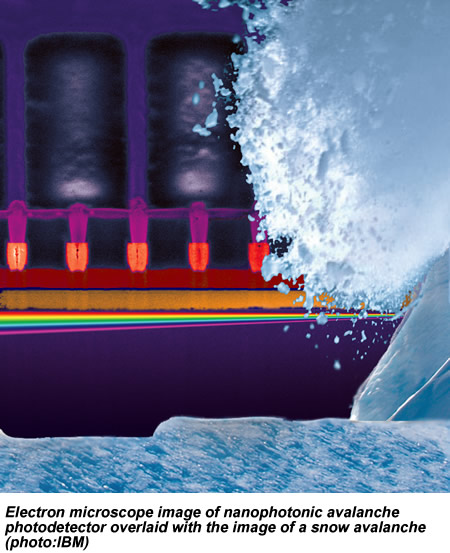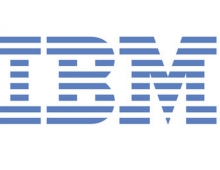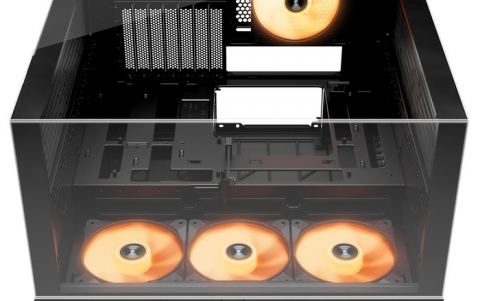
Progress In Photodetectors Paves the Way For The Development Of Exaflop Computers
IBM scientists today unveiled a significant step towards replacing electrical signals that communicate via copper wires between computer chips with tiny silicon circuits that communicate using pulses of light.
As reported in the recent issue of the scientific journal Nature, this is an important advancement in changing the way computer chips talk to each other.
The device, called a nanophotonic avalanche photodetector, is the fastest of its kind and could enable breakthroughs in energy-efficient computing that can have significant implications for the future of electronics.
The IBM device explores the "avalanche effect" in Germanium, a material currently used in production of microprocessor chips. Analogous to a snow avalanche on a steep mountain slope, an incoming light pulse initially frees just a few charge carriers which in turn free others until the original signal is amplified many times. Conventional avalanche photodetectors are not able to detect fast optical signals because the avalanche builds slowly.
"This invention brings the vision of on-chip optical interconnections much closer to reality," said Dr. T.C. Chen, vice president, Science and Technology, IBM Research. "With optical communications embedded into the processor chips, the prospect of building power-efficient computer systems with performance at the Exaflop level might not be a very distant future."
The avalanche photodetector demonstrated by IBM is the world?s fastest device of its kind. It can receive optical information signals at 40Gbps (billion bits per second) and simultaneously multiply them tenfold. Moreover, the device operates with just a 1.5V voltage supply, 20 times smaller than previous demonstrations. Thus many of these tiny communication devices could potentially be powered by just a small AA-size battery, while traditional avalanche photodetectors require 20-30V power supplies.
"This dramatic improvement in performance is the result of manipulating the optical and electrical properties at the scale of just a few tens of atoms to achieve performance well beyond accepted boundaries," said Dr. Assefa, the lead author on the paper. "These tiny devices are capable of detecting very weak pulses of light and amplifying them with unprecedented bandwidth and minimal addition of unwanted noise."
In IBM?s device, the avalanche multiplication takes place within just a few tens of nanometers (one-thousandths of a millimeter) and that happens very fast. The tiny size also means that multiplication noise is suppressed by 50% - 70% with respect to conventional avalanche photodetectors. The IBM device is made of Silicon and Germanium, the materials already widely used in production of microprocessor chips. Moreover it is made with standard processes used in chip manufacturing. Thus, thousands of these devices can be built side-by-side with silicon transistors for high-bandwidth on-chip optical communications.
The Avalanche Photodetector achievement, which is the last in a series of prior reports from IBM Research, is the last piece of the puzzle that completes the development of the "nanophotonics toolbox" of devices necessary to build the on-chip interconnects.
IBM has a long history of pioneering advanced silicon technologies to help enhance performance, while reducing size and power consumption. Such advances include the development of the world?s first copper-based microprocessor; silicon-on-insulator (SOI), a technology that reduces power consumption and increases performance by helping insulate the millions of transistors on a chip; and strained silicon, a technology that "stretches" material inside the silicon decreasing the resistance and speeding the flow of electrons through transistors.

The device, called a nanophotonic avalanche photodetector, is the fastest of its kind and could enable breakthroughs in energy-efficient computing that can have significant implications for the future of electronics.
The IBM device explores the "avalanche effect" in Germanium, a material currently used in production of microprocessor chips. Analogous to a snow avalanche on a steep mountain slope, an incoming light pulse initially frees just a few charge carriers which in turn free others until the original signal is amplified many times. Conventional avalanche photodetectors are not able to detect fast optical signals because the avalanche builds slowly.
"This invention brings the vision of on-chip optical interconnections much closer to reality," said Dr. T.C. Chen, vice president, Science and Technology, IBM Research. "With optical communications embedded into the processor chips, the prospect of building power-efficient computer systems with performance at the Exaflop level might not be a very distant future."
The avalanche photodetector demonstrated by IBM is the world?s fastest device of its kind. It can receive optical information signals at 40Gbps (billion bits per second) and simultaneously multiply them tenfold. Moreover, the device operates with just a 1.5V voltage supply, 20 times smaller than previous demonstrations. Thus many of these tiny communication devices could potentially be powered by just a small AA-size battery, while traditional avalanche photodetectors require 20-30V power supplies.
"This dramatic improvement in performance is the result of manipulating the optical and electrical properties at the scale of just a few tens of atoms to achieve performance well beyond accepted boundaries," said Dr. Assefa, the lead author on the paper. "These tiny devices are capable of detecting very weak pulses of light and amplifying them with unprecedented bandwidth and minimal addition of unwanted noise."
In IBM?s device, the avalanche multiplication takes place within just a few tens of nanometers (one-thousandths of a millimeter) and that happens very fast. The tiny size also means that multiplication noise is suppressed by 50% - 70% with respect to conventional avalanche photodetectors. The IBM device is made of Silicon and Germanium, the materials already widely used in production of microprocessor chips. Moreover it is made with standard processes used in chip manufacturing. Thus, thousands of these devices can be built side-by-side with silicon transistors for high-bandwidth on-chip optical communications.
The Avalanche Photodetector achievement, which is the last in a series of prior reports from IBM Research, is the last piece of the puzzle that completes the development of the "nanophotonics toolbox" of devices necessary to build the on-chip interconnects.
IBM has a long history of pioneering advanced silicon technologies to help enhance performance, while reducing size and power consumption. Such advances include the development of the world?s first copper-based microprocessor; silicon-on-insulator (SOI), a technology that reduces power consumption and increases performance by helping insulate the millions of transistors on a chip; and strained silicon, a technology that "stretches" material inside the silicon decreasing the resistance and speeding the flow of electrons through transistors.






















